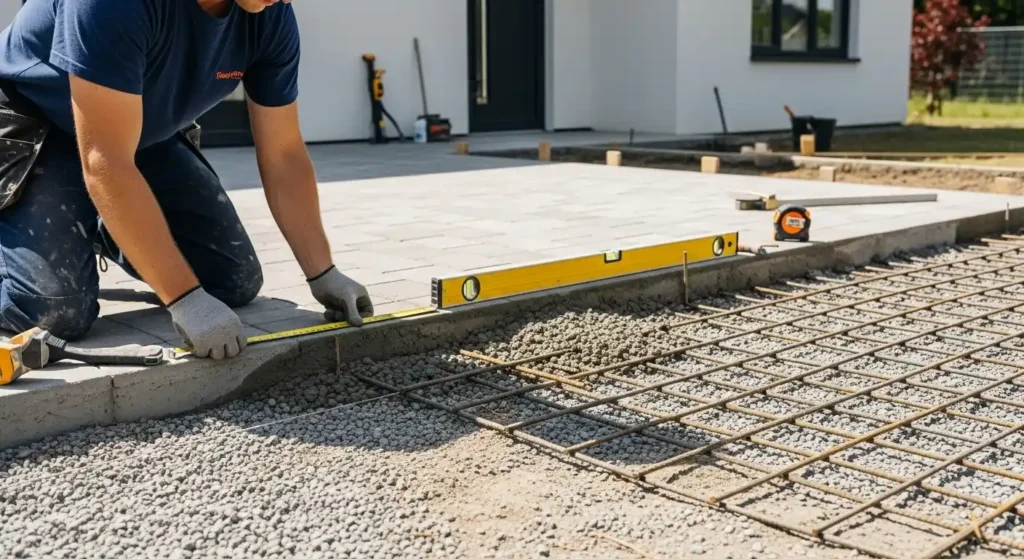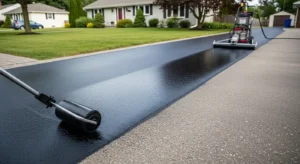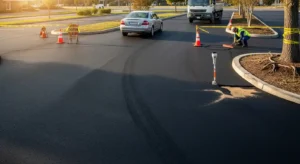Getting the thickness right makes the difference between a walkway that lasts decades and one that cracks within years. I’ve seen homeowners waste thousands on repairs because they skimped on depth during installation.A concrete walkway needs to be 4 inches thick. This applies to residential properties where you’ll have regular foot traffic.
Commercial spaces with heavier use require 5-6 inches.But thickness alone won’t save you from cracks. You need proper base preparation, reinforcement, and curing.
Why 4 Inches Works for Most Walkways
The 4-inch standard exists for good reasons. It’s not just a number contractors pulled from thin air.First, this depth handles freeze-thaw cycles without cracking. Water seeps into concrete, freezes, expands, and can destroy thinner slabs. Four inches gives you enough mass to resist this cycle.
Second, it distributes weight properly. When someone walks across your sidewalk or pushes a loaded wheelbarrow, that force spreads across the concrete and into the soil below.Third, it’s cost-effective. Yes, thicker would be stronger. But you’d spend significantly more on materials for minimal benefit in residential applications.
When You Need More Than 4 Inches
Some situations demand extra depth. Heavy equipment areas need 5 inches if you’ll regularly move riding mowers across the walkway. Poor soil conditions like expansive clay or loose sandy soil benefit from the extra depth too. Tree root zones create uneven pressure from below, and an extra inch helps distribute these forces.
How Thick Should Your Concrete Driveway Be?
Driveways face much heavier loads than walkways. You need 4 inches minimum, but 5-6 inches works better.Here’s why contractors push for that extra depth: your car weighs 3,000-4,000 pounds. That weight concentrates on four small contact patches where tires meet concrete. When you turn your steering wheel while the car sits still, those forces twist the concrete.
Breaking Down Driveway Thickness By Vehicle Type
Passenger cars and SUVs – 4 inches meets the bare minimum. But I’d recommend 5 inches. The cost difference is minimal compared to replacement.
Trucks and RVs – 6 inches becomes necessary. These vehicles create concentrated loads that will damage thinner concrete.
Commercial properties – 6-8 inches handles delivery trucks, service vehicles, and constant traffic.
Concrete Patio Thickness Requirements
Your patio needs 4 inches for standard use. This covers outdoor furniture, grills, and normal foot traffic.But consider what you’re planning to put on that patio. A hot tub weighs several thousand pounds when filled. You need 6 inches under and around hot tubs. Outdoor kitchens create similar concerns.
The area under these features should be 5-6 inches thick.Large patios over 500 square feet benefit from extra thickness too. The bigger the slab, the more it can shift and crack.
Understanding Sidewalk Thickness Standards
Municipal codes typically specify 4-6 inches for public sidewalks. Residential sidewalks almost always use 4 inches. It handles foot traffic perfectly and costs less than thicker alternatives.Commercial district sidewalks often reach 6 inches. Restaurants receive deliveries across these sidewalks, and maintenance vehicles occasionally drive on them.
Garage Floor Concrete Depth
Garage floors should be 4-6 inches thick. A basic garage where you park your car works fine with 4 inches. But most people use garages for more than parking.If you plan to use a floor jack, install a lift, or work with heavy machinery, install 6 inches. The extra cost is minimal during initial construction.
Choosing the Right Concrete Mix
Concrete strength matters as much as thickness. You’ll see mixes labeled by PSI (pounds per square inch).3000-4000 PSI handles most residential walkways and patios. This mix balances cost and strength appropriately.
4000-5000 PSI suits driveways and garage floors. The higher strength resists cracking under vehicle loads.Don’t confuse cement with concrete. Cement is one ingredient in concrete. The complete mix includes cement, sand, aggregate (gravel), and water.
Reinforcement Methods to Prevent Concrete Cracks
Even with the right thickness, concrete can still crack without proper reinforcement. The goal is to strengthen the slab from within so it can handle tension and environmental stress.
1. Steel Rebar – The Strongest Option
Steel rebar gives concrete the tensile strength it naturally lacks. Arrange #4 rebar in a grid pattern spaced 12–18 inches apart. This method is ideal for driveways, garage floors, and other heavy-use areas. Even if small cracks appear, the rebar keeps the slab tightly bonded and structurally sound.
2. Wire Mesh – Lightweight and Effective
Wire mesh forms a 6×6-inch grid that provides reliable crack control for most residential projects. It’s easier to handle than rebar and works well for standard walkways, patios, and light-use slabs.
3. Fiber Reinforcement – Simple and Convenient
Synthetic fibers are mixed directly into the wet concrete, eliminating the need to lay steel reinforcement. They’re a great choice for basic walkways or smaller areas, helping to minimize surface cracking and speed up installation.
Preparing the Base Before You Pour
You can’t just pour concrete on dirt and expect good results.Excavate 8-10 inches total depth. You need room for 4 inches of gravel base plus 4 inches of concrete. Install and compact the gravel thoroughly. This layer provides drainage and prevents settling.
Build forms from 2×4 or 2×6 lumber. These hold concrete at the correct depth while it cures. Level them carefully – you can’t easily fix slopes after pouring.
Installation Steps for Concrete Walkways
Start by marking your walkway path. Standard residential walkways are 36-48 inches wide. Wider looks better and allows two people to walk side-by-side comfortably.Excavate to proper depth across the entire path. Inconsistent depth creates weak spots. Install and compact your gravel base.
This step determines how well your walkway performs long-term.Build forms and install reinforcement. Double-check everything is level and properly positioned.
Pour concrete and work quickly. You have a limited window before it becomes difficult to finish. Smooth the surface, add texture if desired, and create clean edges.Start curing immediately. Keep concrete moist for seven days. Concrete that dries too quickly never reaches full strength.
Determining Proper Walkway Width
Width affects usability as much as thickness affects durability.
36 inches allows one person to walk comfortably. This works for secondary paths through gardens or side yards.
48 inches accommodates two people walking together. This suits main walkways from driveways to front doors.
60 inches creates impressive entries and handles wheelchairs easily. Consider this for primary approaches to your home.
Curing Time Before You Can Use New Concrete
You can’t rush concrete curing. The chemical reaction that creates strength takes time.Wait 24-48 hours before walking on new concrete. Light foot traffic won’t damage fully cured concrete, but fresh concrete is vulnerable.
Keep vehicles off for seven days minimum. This applies to driveways. I know it’s inconvenient. But driving on fresh concrete creates permanent damage. Tire marks, cracks, and surface degradation result from premature traffic.
Full strength develops over 28 days. Concrete reaches about 90% of final strength after a week.
Common Mistakes to Avoid
Don’t pour 2-inch thick walkways. Some contractors suggest this to save money. It’s a mistake. Two inches will crack quickly under any use. Specialty overlays can be 2 inches when poured over existing concrete, but standalone 2-inch slabs fail consistently.
Don’t skip the gravel base. Pouring directly on soil causes settling and cracking. That 4-inch gravel layer costs relatively little but prevents expensive problems.Don’t forget expansion joints. Concrete expands and contracts with temperature changes. Without joints every 4-6 feet, it will crack randomly.
Weather Considerations for Concrete Work
Temperature affects concrete curing significantly.
Don’t pour when temperatures will drop below 40°F within 24 hours. Cold stops the chemical reaction that creates strength. Extremely hot weather (above 90°F) creates different problems. Concrete sets too quickly, making finishing difficult.Spring and fall offer ideal conditions in most climates.
Cost Factors for Different Thicknesses
Material costs increase with thickness. A 6-inch slab uses 50% more concrete than a 4-inch slab.But consider total project cost. Labor doesn’t increase much for thicker concrete. The concrete itself is often less than half of total project cost.
Spending 10-15% more on extra thickness often makes sense. Replacement costs far exceed the initial savings from thinner concrete.
Working With Contractors on Concrete Projects
Get multiple quotes, but don’t choose based solely on price. The lowest bid often means corners will be cut.Ask specifically about thickness, reinforcement, and base preparation. Some contractors will quote 4 inches but pour closer to 3.5 inches. That half-inch matters.Verify they’ll use proper PSI-rated concrete for your application.
Long-Term Maintenance for Concrete Surfaces
Even properly installed concrete needs maintenance.Seal your concrete every 2-3 years. Sealers prevent water penetration, which causes freeze-thaw damage. Fill cracks promptly when they appear. Small cracks expand over time.
Keep drainage working properly. Water that pools on or near concrete accelerates deterioration.
Making Your Decision on Concrete Thickness
You now know the standards: 4 inches for walkways, 5-6 inches for driveways, 4 inches for patios with exceptions for heavy features.These standards evolved from decades of experience. Don’t shortcut thickness to save a few hundred dollars. You’re building something that should last 30-50 years.
Work with experienced contractors who understand local soil conditions and climate factors. Get the thickness right from the start. You can’t easily add thickness later without complete replacement.
Ready to Install Your Concrete Project?
Planning your concrete walkway, driveway, or patio doesn’t have to be overwhelming. While understanding thickness requirements is crucial, professional installation makes all the difference in longevity and performance.
If you’re in the area Arizona and need expert concrete work, SS Paving brings years of experience to every project. They know local soil conditions, climate challenges, and building codes. More importantly, they get the thickness right the first time – no shortcuts, no comebacks.
Whether you need a simple walkway or a complete driveway installation, working with professionals who understand proper base preparation, reinforcement, and curing techniques protects your investment. You’re not just buying concrete – you’re buying peace of mind that it’ll last decades.
Frequently Asked Questions
Can I pour concrete directly on grass or soil?
No, don’t pour concrete on grass or soil. You’ll get cracks and settling within a year. Remove all vegetation first and install a 4-inch compacted gravel base. This base provides drainage and prevents uneven settling. Grass and roots decompose under concrete, creating voids that cause cracks.
What’s better for a driveway – 4 inches or 6 inches of concrete?
Six inches works better for most driveways. The extra 2 inches costs about 15-20% more but can double your driveway’s lifespan. You’re not just parking – you’re turning the steering wheel while stationary, which twists the concrete. Delivery trucks and visitor vehicles add stress too. I’ve seen 4-inch driveways crack in 5-7 years, while 6-inch versions last 20+ years.
How long after pouring concrete can I walk on it?
Wait 24-48 hours before walking on new concrete. The surface looks dry quickly, but it’s soft underneath. For vehicles, wait a full 7 days minimum. Concrete reaches 70% strength in 7 days and 90% after 28 days. Keep it moist by spraying water 2-3 times daily during the first week.
Do I need rebar in a 4-inch concrete walkway?
You don’t absolutely need rebar for standard walkways, but it’s good insurance. Wire mesh or fiber reinforcement works fine for basic foot traffic. Rebar becomes necessary if you’ll drive equipment across it, have expansive soil, or face harsh freeze-thaw cycles. The cost during installation is minimal compared to future repairs.
Can I make my concrete thicker in some spots and thinner in others?
It’s a bad idea in most cases. Inconsistent thickness creates stress points where sections meet, and these spots crack first. The exception is deliberately thickening areas for heavy loads – like a 6-inch hot tub pad on a 4-inch patio. For standard projects, maintain consistent thickness throughout.






